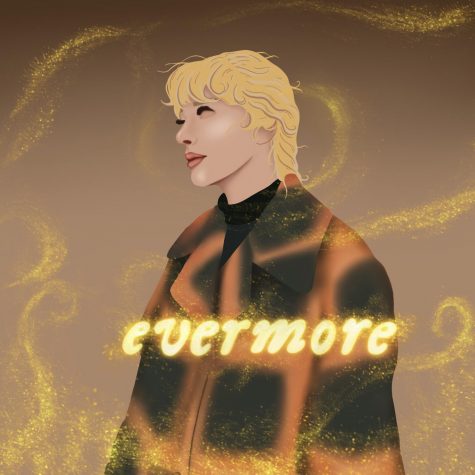Swift’s ‘Evermore’: Narrative songwriting at its finest
January 14, 2021
Does Taylor Swift ever sleep? All bets are on “no.”
A mere four months after the release of her widely successful, surprise release, “folklore,” Swift has returned with “evermore,” the sister
album packed with more stories to tell. Fans were in utter disbelief on Dec. 10, 2020 when Swift announced that her new album and music video for “Willow” would release at midnight.
Now the bonus track edition has been released and fans have been gifted with two more tracks, making a total of 34 songs from the folklore/evermore era. How does Swift continue to release quality music at such a rapid rate all while quarantined in her home? We may never know, besides the fact that she continues to work with collaborators Jack Antonoff, Justin Vernon or Bon Iver, Aaron Dessner of The National and “William Bowery.”
Swift has finally confirmed what many fans have speculated since the release of folklore: William Bowery is a ghost-writing name for Swift’s boyfriend of the last four years, British actor Joe Alwyn.
The truth is that Swift is in the prime of her own creativity nearly fifteen years after the start of her career, but with an artist like her, one never knows when her “prime” is. Many would have said that the “Fearless” era was her prime, then “1989,” yet now her work is better than ever. This is her peak…for the moment, but she could so easily have another.
“Willow” picks up right at the end of the “single thread of gold” in “folklore.” Its soft pop, guitar picked melody carries poetic lyrics like “life was a willow and it bent right to your wind.” The song tells of the love she found for Alwyn and the way it took her by surprise, a theme recurring on “reputation.” One of the most notable lines is “they count me out time and time again… but I come back stronger than a 90s trend.” This
line refers to her resilience that I previously mentioned.
One of the best songs Swift has ever written and performed is “champagne problems.” The song was co-written by Alwyn, and contrary to their own story, is about a failed relationship. The narrator has just turned down a proposal from her long-time partner. She discusses her own mental illness and echoes what people are saying about her. She pictures what her nowex-lover is thinking and how he is feeling. The lyricism on this track is unmatched. It leaves the listener with the same inner burning feeling as “All too Well” and “Dear John.” The song ends with her assuring him
that he will find someone else to replace her and she will be everything he wants and needs: “your mom’s ring in your pocket, her picture in your wallet, you won’t remember all my champagne problems.”
“Gold Rush” is a fast paced dream of a relationship. It covers the pure feeling of new love, jealousy and a bitter ending. Lyrics like “I don’t like that falling feels like flying ‘til the bone crush,” make for picturesque heartbreak that has blown by before you can grasp it.
Although Swift has been in a consistent relationship for over four years, she manages to write brilliant songs about varying situations, whether or not they are based on her own life. In “tis the d*** season she plays the part of a girl trying to make it in Hollywood who begrudgingly goes home for the holidays and calls her high school ex to cure her loneliness. As the track unfolds, it’s evident that this is not the first time this has happened, but she calls for a truce: “I won’t ask you to wait if you don’t ask me to stay.”
“Tolerate It” is a cry for help from a woman who knows that her partner has fallen out of love with her, yet continues to try to win his affection again. It can be summarized with its key line, “I know my love should be celebrated, but you tolerate it.” This track leads into the fan-favorited collaboration with HAIM, “no body, no crime,” a tale from the perspective of a woman whose friend Este has just been murdered by her cheating husband. This track order leads me to think that “tolerate it” is Este’s last cry for help before she is killed. Swift’s character seeks revenge on her ex husband and his mistress, and as one twitter user stated, “I can’t believe it took Taylor Swift nine albums to sing about killing a man.” Good thing
his mistress took out a big life insurance policy…
“Please picture me in the trees,” Swift opens “seven,” the seventh track on “folklore.” “Honey, when I’m above the trees, I see this for what it is,” Swift
opens “happiness,” the seventh track on “evermore.” “Happiness” is one of Taylor’s most mature songs to date. Many are referring to it as a “woke” breakup anthem. She goes through all of the motions of ending a long-term relationship and addresses both her negative and positive thoughts. A main theme on this track is the “reinvention” that must occur after
making a major life change. “I pulled your body into mine every night, now I get fake niceties. No one teaches you what to do when a good man hurts
you, and you know you hurt him too,” she sings.
A friend sings longingly about missing their high school friend in “ dorothea.” There are many clues in the lyrics that suggest that Dorothea is the girl from “tis the d*** season.” That’s one of the beautiful
things about this era of music: you can take what you are given and imagine it anyway you want to.
“Coney Island” featuring the National is noted by fans for having references to lyrics she’s written in the past about many of her famous exes including Harry Styles, Jake Gyllenhal, John Mayer and Calvin Harris.
One of the truest gems on the album is “ivy,” a tale of an illicit affair. With repeated listens this track grew on me, just like the premise described in the lyrics, but since my very first listen to “evermore,” “cowboy like me” has been in my top three tracks.
CLM was discounted by many listeners, but it is one of Swift’s most picturesque fictional works. It tells the tale of two bandits who can’t help but to fall in love because of the similarities in their souls, but because of their rogue lifestyles, are forced apart. “With you boots beneath my bed,
forever is the sweetest con,” she sings after the thrill of the encounter has passed.
“ Long story short it was a bad time,” Swift sings of the events of 2016, which were the subject of 2017’s “reputation.” “Long story short, I survived,” she triumphantly concludes.
“Marjorie” is the diamond-in-the-rough masterpiece of this record. This tribute to her late grandmother features what is one of the most heartfelt
bridges in Swift’s catalogue, as she scraps together memories of the woman she admires. She curses her young self for childishly complaining about time spent with her instead of cherishing the few moments she had.
She lovingly mimics her grandmother’s advice: “never be so kind you forget to be clever; never be so clever you forget to be kind / never be so polite you forget your power; never wield such power you forget to be polite.” I will admit that I believe “marjorie” to be the last truly magnificent track on the standard album. “Closure” is in the low rankings of her catalogue for me. “Evermore” featuring Bon Iver is a worthy closer to the album, but is lacking in comparison to “folklore”’s “exile.” The bonus tracks for “evermore” released on Jan 8. “Right where you left me” is a country influenced tale of a girl who never finds it in herself to get over her first love.
“It’s time to go” is the perfect closing letter to Big Machine Record’s Scott Borchetta and Scooter Braun, the owners of her first six albums, before
she re-releases the albums in 2021. She reaches closure in the bridge: “he’s
got my past frozen behind glass, but I’ve got me.”
“Evermore is narrative songwriting in all its glory. As a huge Swift fan, I am so proud to get to witness this period of creativity.













